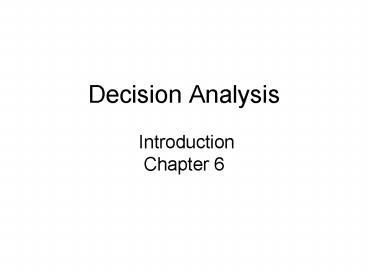Decision Analysis Introduction Chapter 6 - PowerPoint PPT Presentation
1 / 16
Title:
Decision Analysis Introduction Chapter 6
Description:
Decision Analysis Introduction Chapter 6 What kinds of problems ? Decision Alternatives ( what ifs ) are known States of Nature and their probabilities are known ... – PowerPoint PPT presentation
Number of Views:149
Avg rating:3.0/5.0
Title: Decision Analysis Introduction Chapter 6
1
Decision Analysis Introduction Chapter 6
2
What kinds of problems ?
- Decision Alternatives (what ifs) are known
- States of Nature and their probabilities are
known (ex. rainy 20, partly cloudy 50, sunny
20) - Outcomes, (referred to as Payoffs) are
computable under different possible scenarios
each is a combination of a decision alternative
and a state of nature
3
Decision Analysis Basic Terms
- Decision Alternatives
- States of Nature (eg. Condition of economy or
weather) - Payoffs ( outcome of a choice assuming a state
of nature) - Criteria (i.e. Expected Value)
4
Decision Analysis Conditions
- Certainty
- Decision Maker knows with certainty what the
state of nature will be - only one possible state
of nature - Ignorance
- Decision Maker knows all possible states of
nature, but does not know probability of
occurrence - Risk
- Decision Maker knows all possible states of
nature, and can assign probability of occurrence
for each state this will be our focus
5
Decision Making Under Certainty
6
Decision Making Under Ignorance Payoff Table
Kelly Construction Payoff Table (Prob. 8-17)
7
Decision Making Under Ignorance
- Which alternative will we choose?
- Maximax
- Select the strategy with the highest possible
return - Maximin
- Select the strategy with the smallest possible
loss
8
Maximax The Optimistic Point of View
- Select the best of the best strategy
- Evaluates each decision by the maximum possible
return associated with that decision (Note if
cost data is used, the minimum return is best) - The decision that yields the maximum of these
maximum returns (maximax) is then selected - For risk takers
- Doesnt consider the down side risk
- Ignores the possible losses from the selected
alternative
9
Maximax Example
Kelly Construction
10
Maximin The Pessimistic Point of View
- Select the best of the worst strategy
- Evaluates each decision by the minimum possible
return associated with the decision - The decision that yields the maximum value of the
minimum returns (maximin) is selected - For risk averse decision makers
- A protect strategy
- Worst case scenario the focus
11
Maximin
Kelly Construction
12
Decision Making Under Risk
- Expected Return (ER)
- Select the alternative with the highest expected
return - Use a weighted average of the possible returns
for each alternative, with probabilities used as
weights - Also referred to as Expected Value (EV) or
Expected Monetary Value (EMV)
13
Expected Return
Note that we now have probabilities for each
state of nature
14
Expected Value of Perfect Information
- EVPI measures how much better you could do on
this decision if you could always know when each
state of nature would occur, where - EVUPI Expected Value Under Perfect Information
(also called EVwPI, the EV with perfect
information, or EVC, the EV under certainty) - EVUII Expected Value of the best action with
imperfect information (also called EVBest ) - EVPI EVUPI EVUII
- EVPI tells you how much you are willing to pay
for perfect information (or is the upper limit
for what you would pay for additional imperfect
information!)
15
Expected Value of Perfect Information
16
Using Excel to Calculate EVPI Formulas View
Kelly Construction































